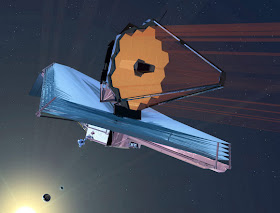
The James Webb Space Telescope (JWST) is a planned infrared space observatory, the partial successor to the aging Hubble Space Telescope. The JWST will not be a complete successor, because it will not be sensitive to all of the light wavelengths that Hubble can see. The main scientific goal is to observe the most distant objects in the universe, those beyond the reach of either ground based instruments or the Hubble. The JWST project is a NASA-led international collaboration with contributors in fifteen nations, the European Space Agency and the Canadian Space Agency.
Current plans call for the telescope to be launched on an Ariane 5 rocket in June 2014, on a five-year mission (10 year goal). The JWST will reside in solar orbit near the Sun-Earth L2 point, which is on a line passing from the Sun to the Earth, but about 1.5 million km farther away from the Sun than is the Earth. This position, which moves around the Sun in exact orbital synchrony with the Earth, will allow JWST to shield itself from infrared from both Sun and Earth, by using a single radiation shield positioned between the telescope and the Sun-Earth direction.

Current plans call for the telescope to be launched on an Ariane 5 rocket in June 2014, on a five-year mission (10 year goal). The JWST will reside in solar orbit near the Sun-Earth L2 point, which is on a line passing from the Sun to the Earth, but about 1.5 million km farther away from the Sun than is the Earth. This position, which moves around the Sun in exact orbital synchrony with the Earth, will allow JWST to shield itself from infrared from both Sun and Earth, by using a single radiation shield positioned between the telescope and the Sun-Earth direction.

Orbit
To avoid swamping the very faint astronomical signals with radiation from the telescope, the telescope and its instruments must be very cold. Therefore, JWST has a large shield that blocks the light from the Sun, Earth, and Moon, which otherwise would heat up the telescope, and interfere with the observations. To have this work, JWST must be in an orbit where all three of these objects are in about the same direction. The answer was to put JWST in an orbit around the Earth-Sun L2 point.

The L2 orbit is an elliptical orbit about the semi-stable second Lagrange point. The Earth-Sun L2 point, about which the Webb telescope will orbit, is 1.51 million km from the Earth, which is about 3.92 times farther away from Earth than is the moon. This distance underscores how much more difficult the Webb telescope would be to service, after launch.

In the case of JWST, the three bodies involved are the Sun, the Earth and the JWST. Normally, an object circling the Sun further out than the Earth would take more than one year to complete its orbit. However, the balance of gravitational pull at the L2 point (in particular, the extra pull from Earth as well as the Sun) means that JWST will keep up with the Earth as it goes around the Sun. The combined gravitational forces of the Sun and the Earth can hold a spacecraft at this point, so that in theory it takes no rocket thrust to keep a spacecraft in orbit around L2.
Optics
Although JWST has a planned mass half that of the Hubble, its primary mirror (a 6.5 meter diameter gold-coated beryllium reflector) has a collecting area which is almost six times larger. As this diameter is much larger than any current launch vehicle, the mirror is composed of 18 hexagonal segments, which will unfold after the telescope is launched. These mirrors are currently being developed by Axsys Technologies in Cullman, Alabama. Sensitive micromotors and a wavefront sensor will position the mirror segments in the correct location, but subsequent to this initial configuration they will only rarely be moved; this process is therefore much like an initial calibration, unlike terrestrial telescopes like the Keck which continually adjust their mirror segments using active optics to overcome the effects of gravitational and wind loading.

Source : universe today and wikipedia

In the case of JWST, the three bodies involved are the Sun, the Earth and the JWST. Normally, an object circling the Sun further out than the Earth would take more than one year to complete its orbit. However, the balance of gravitational pull at the L2 point (in particular, the extra pull from Earth as well as the Sun) means that JWST will keep up with the Earth as it goes around the Sun. The combined gravitational forces of the Sun and the Earth can hold a spacecraft at this point, so that in theory it takes no rocket thrust to keep a spacecraft in orbit around L2.
Optics
Although JWST has a planned mass half that of the Hubble, its primary mirror (a 6.5 meter diameter gold-coated beryllium reflector) has a collecting area which is almost six times larger. As this diameter is much larger than any current launch vehicle, the mirror is composed of 18 hexagonal segments, which will unfold after the telescope is launched. These mirrors are currently being developed by Axsys Technologies in Cullman, Alabama. Sensitive micromotors and a wavefront sensor will position the mirror segments in the correct location, but subsequent to this initial configuration they will only rarely be moved; this process is therefore much like an initial calibration, unlike terrestrial telescopes like the Keck which continually adjust their mirror segments using active optics to overcome the effects of gravitational and wind loading.

Source : universe today and wikipedia
No comments:
Post a Comment